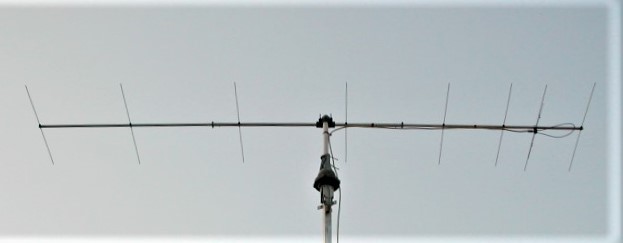
M2 and I0JXX Antennas for the 144 MHz Band
Received the 8JXX2 antenna on Friday and built it up on Sunday. I also have a new M2-2M9SSB antenna recently assembled so here are a few comparison notes on mechanical and build quality. The specified electrical performance is very similar. Both antennas make use of stainless steel fasteners.
For my use, one of the antennas is intended for portable operation and the other will end up on the roof as a fixed installation.
The mast clamp supplied with the M2 is a rectangular aluminium drilled plate. The new I0JXX mast clamp is also a pre drilled metal plate but the rectangle corners have been cut off to reduce the size and weight. The thickness of the aluminium used is greater than that of the M2 clamp plate. The previous I0JXX clamp was an aluminium casting, large and bulky so this is a good improvement.
English translation in the instructions could be improved in areas for I0JXX antenna.
Both antennas have circular aluminium tube booms which are tapered by three sections of different diameter. The I0JXX antenna has an alchromate finish and heavier gauge aluminium. Boom sections are fastened together with a single bolt / nut / washer and stainless steel hose clip clamp. The M2 antenna has swaged boom sections fastened together with a pair of bolt / nut / washers. The I0JXX antenna system is more rigid but heavier. The M2 has slight play in the boom sections once assembled.
When the elements on the M2 antenna are fitted and fastened in place they cannot be easily removed and should be regarded as a permanent fitting. Not so good for portable operating as transporting this antenna takes up more volume and it is more prone to damage. The elements also have to be carefully measured for selection of the correct element position and for centralising on the boom during this part of the installation. The method of fitting the elements is far superior on the I0JXX antenna, especially for portable use where frequent fitting and disassembly will be required. Firstly, the antenna elements have a corresponding element number stamped on them. Second, the elements come pre fitted and centred though a polyoxymethylene (POM) bolt which isolates the element from the boom. A POM nut is fitted over the other end of the element which secures it in place.
With the I0JXX antenna, one of the elements and the driven element were slightly misaligned. In the case of the director alignment it appeared to be a problem with the hole drilled in the boom. The dipole element misalignment could also be attributed to this although it may have been exacerbated by a lose captive bolt. There were no alignment issues noticeable with the M2 antenna.
Minor alignment issues aside, both dipole driven elements are similar in design and well made. Both use T-match and 75 Ohm coax matching section. The M2 antenna has a removable SAT-TV matching coax section fitted with sealed F type connectors. The I0JXX antenna matching section uses PTFE type coax which is permanently fitted and sealed to the driven element assembly.
Price (May 2020):-
8JXX2 £121
2M9SSB £253
Summary, assumes main use is portable. Both antennas have good and bad points. Ideally I would have a hybrid comprising the following:
– M2 boom swaged sections and element hole machining accuracy
– I0JXX boom fastening system and alchromate finish
– I0JXX element to boom fastening method
– I0JXX mast coupling clamp plate
– I0JXX price
Overall, and given the price differential, I would tend towards the I0JXX antenna for portable use.
Both these aluminium alloy antennas come with stainless steel fasteners and fixings. This is not the best solution for a permanent installation. Zinc plated steel fasteners would provide a lower galvanic potential and therefore reduced corrosion at dissimilar metal contact points. For further information refer to MIL-STD-889C.
© Norman Stewart GM1CNH
